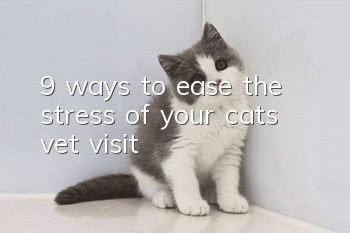9 ways to ease the stress of your cat’s vet visit

Sometimes it is unavoidable to take cats to the hospital for medical treatment, especially in households with multiple cats or catteries. For cats, going to the hospital is actually a hassle.
We know that most cats have glassy hearts, and stress has a great impact on them. Being sick is inherently a stressful event. Coupled with a "horrible journey" full of unknowns (on the way to the hospital and in the hospital), the cat's overall stress level may be even greater!
When the pressure is overloaded, it may be a minor illness, but after a trip to the hospital, the illness may become serious.
Below, we will explain 9 methods to make your cat’s trip to the hospital as stress-free as possible.
1. Your emotions will affect the cat
Animals can sense our emotions. The same goes for cats and dogs as companion pets.
Therefore, if you plan to take your cat to the hospital, it is very, very important for you to stay calm. Even your subtle emotional changes can be sensed by cats. They observe you carefully.
Try to maintain emotional restraint and don’t let your cat suspect that you have something on your mind.
If you act nervous, the cat will think that nothing good is going to happen. When it gets on the road, enters the vehicle, gets in the car, and then goes to the hospital, the cat will let the doctor touch it. It becomes very tense and anxious.
Also have a list of hospitals and doctors on hand, including the phone number of a hospital that is open 24 hours a day. Before going to the hospital, call the doctor first to ask for some details, which will help you stay rational and calm.
2. Let the cat get used to being handled
Some cats, due to personality issues, may not like to be handled. Of course, there are also many that just want to play with.
Part of this depends on inherited personality, and part of it depends on whether you developed habits when you were a child. Therefore, the method of training a cat to get used to being handled is also very simple. Just play with it as soon as you get it home. For example, lift its paws, touch its toes, open its mouth, check its ears and teeth, touch its abdomen, back, thighs, etc.
Excellent breeders will start these artificial contacts half a month after the cat is born, and try to further cultivate the character of the cat's relatives through acquired methods.
3. Use vehicles it is familiar with (flight boxes, cat bags, etc.)
Cats are very territorial animals, so the more familiar the environment is to themThe safer it is.
Therefore, it is best for cats to have their own dedicated vehicles if there are too many cats at home. At least let them get familiar with the feeling of being in a vehicle.
You can start this training on weekdays. When you have nothing to do, you can put the cat in the carrier for half an hour, then let it out, and train it once a week, or more frequently.
In this way, after a few times, they will become familiar with this vehicle. There will be no sense of strangeness or fear just because you suddenly have to take it to the hospital or put it in a vehicle.
4. Put some snacks and a "security blanket" in the vehicle
Snacks are not difficult to understand. Eat a few bites and you will feel better. Such as freeze-drying, delicious snacks, etc.
The so-called "security blanket" refers to a type of thing. For example, the plush toys it often plays with, the mats on its cat's bed, or its kitten's nest. In short, if it has its smell, anything from commoners will be fine.
These things with familiar smells will give cats a sense of security and reduce stress.
5. Let the cat get familiar with cars
Dogs may ride in cars a lot, but cats don’t.
Therefore, cats who only use cars occasionally may directly associate this bad experience with riding in a car because they go to see the veterinarian.
Therefore, daily training is also necessary. Just like training a cat to use a vehicle, occasionally take the cat out for a few laps with a leash. The journey can take from a few minutes to dozens of minutes, gradually increasing the time taken by car.
People who plan to travel around the world with their cats in the future (do you have such thoughts?) should also train their cats enough in advance.
6. Make an appointment
Make an appointment with the veterinarian as much as possible, plan your route, and avoid traffic jams.
Try to avoid seeing a doctor at crowded times unless it is an emergency. Too many people, too many pets, and too much waiting time will make cats feel extremely anxious.
If you find you have to queue after arriving at the hospital, it is best to wait in the car after communicating with the doctor. This will minimize your cat's stress.
7. Use words to comfort the cat
When the veterinarian opens the vehicle, try to comfort him in the same tone you would normally speak to him.
In this case, it will be givenThey are a feeling of confidence and consistency. You won't be too nervous.
But, if, here’s the important point, your cat is already very nervous, don’t try any form of encouragement or comfort at this time. Just exercise restraint and ignore it. Otherwise, with your encouragement and comfort, it is likely to think that it is right to be so nervous. Therefore, it will be more tense.
At this time, your face is expressionless and you can just pretend that nothing happened.
8. Keep your cat occupied
If it is other pets or people in the hospital, it will scare your cat.
Then you try every means to divert its attention. Let them move, play with cat sticks, and eat some snacks.
9. Find a good veterinarian
A smart and excellent veterinarian will take the initiative to comfort the cat. They will judge the cat's status and then give strategies. It depends on your luck. Anyway, you are very lucky to know a veterinarian with a high level.
- Cats use cat litter but poop randomly
- What should you pay attention to when raising Ragdoll cats at home?
- How to solve the problem when a cat’s nose makes a popping sound
- What should you do if a Persian cat bites people fiercely? Common sense on Persian cat training!
- What are the flaws of cats with different eyes?
- How is cat plague transmitted?
- If you want bone health, vitamin D and cat health!
- Which one is better, hair removal cream or cat grass? A must-read for pet owners!
- Why do cats keep losing weight?
- Is erythromycin ointment poisonous if licked by cats?



